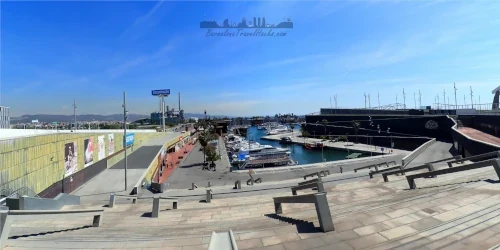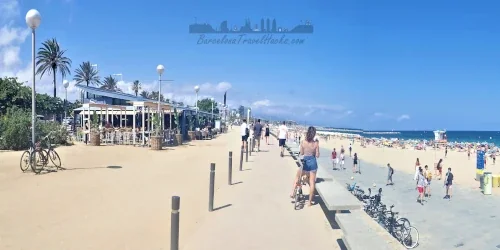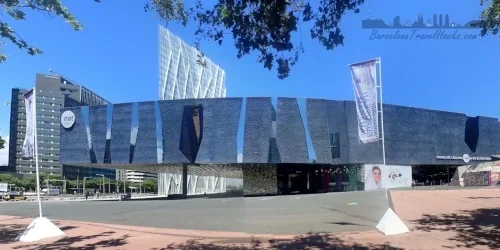Please sign in with Google to view the map.
Sign in with GoogleBesòs Water Tower - Torre de les Aigües del Besòs
A historic modernist industrial brick landmark in the Poblenou and Fòrum neighbourhoods & a beautiful example of water infrastructure in Catalonia
About Besòs Water Tower
The Besos Water Tower, Torre de les Aigües del Besòs, is a historic modernist industrial brick landmark in the Poblenou and Fòrum neighbourhoods. The water tower is considered one of the most beautiful examples of water infrastructure in Catalonia and has been painted or drawn by artists such as Ramon Calsina, Josep M Subirachs and Joan Pallarès.
The water tower was built at a time when poblenou was not residential but industrial and served to feed water to these factories as well as the Cuitadella area of Barcelona city. The start of the project was the discovery of a natural subterranean aquifer that contained water of a good natural purity with low salination.
The Aigües del Besòs water company was formed and a water tower was placed on the site to gravity feed water. The tower was only 51 meters high in 1882, until the first reservoir was constructed on top. The exterior spiral staircase is to ascend aound the large water tank becuse the interior central column was used for the up and down pipes for the water. The tower was envisioned to reach 124 metres with a second tank starting at 80m on top of the first.
Next to the water tower is the Casa de Vàlvules and close by stood the (now demolished) building designed to house the two steam boilers manufactured by the renowned Alexander Hermanos. The boilers were initially fueled with coal from Cardiff. Its function was to supply power to four vertical type steam engines in the Casa de Vàlvules that maneuvered four pumps with the capacity to raise twelve thousand cubic metres of water to 40m for the first water tank and a further twelve thousand cubic metres to 80 meters for the planned second tank which was never constructed. The pipes and valves came from Glasgow and had been designed to withstand 15 atmospheres of pressure.
When it was complete, the complex was designed to provide one hundred thousand cubic metres of water in a twenty four hour period between the two tanks. The water from the aquifer entered the watertower through a gallery at basement level and was pushed up through the central eye of the tower untill it reached the top of the ceramic lined tanks where it was poured in. The downpipe was displaced a few centimeters above the movable galvanized iron sieve or strainer at the bottom of the tank plughole. The tank had measuring devices to guarantee the quality of the water, as well as a temperature control to allow the propulsion and descent system to work automatically.
The construction is of solid brick and was built without the use of structural steel except for the roof rafters of the watertower and Casa de Vàlvules. The tower had to withstand the weight of the water plus the expulsion forces of the water within the pipes. The water tank was circular in shape with braces at he top to counteract the expansion forces from the large volume of water contained within. The tower, wen looking from the top in plan form is composed of three brich rings. a central eye that contained the up and down pipes, each pipe having a diameter of 30cm. A middle ring for strength and an outer ring. the spiral staircase runs between the outer and middle ring. all three rings are interlinked with spokes of brich arches and the Catalan brick vault is used extensively.
The demise of the water tower and the reason for the cancelation of the second tank was that drawing large volumes of fresh water from the subterranean aquifer caused a vacume which drew in more water from the neaby coastline so the aquafer was contaminated with saltwater which was not suitable for factory and residential use so the water tower ceased to operate and fell into disrepear and abandonment.
Pere Falqués i Urpí (1850-1916) obtained the title of architect in 1873 and was the municipal architect of the Sant Martí de Provençals district of Barcelona city. In 1889, jointly with Lluís Domènech i Montaner, held the post of Barcelona city chief architect. He was president of the Association of Architects of Catalonia from 1899 to 1900.
Pere Falqués i Urpí collaborated on works for the 1888 Universal Exhibition held in Parc Cuitadella and later wone the competition to remodel Plaça de Catalunya at the top of Las Ramblas. Pere Falqués also designed much of the ironwork for Barcelona's street furniture such as the iron lampposts on Passeig de Lluís Companys next to Arc de Triomf, The lamp posts in Avinguda de Gaudí and the lamp post benches in Passeig de Gracia infront of Casa Batlló and La Pedrera. He was also the architect for the Besos water tower.
Today, the Besos Water Tower houses the Poblenou historic archives in the Casa de Vàlvules as well as being a museum space and providing guided tours inside the tower and panaramic views from the tower roof.
Besòs Water Tower History
At the end of the 19th century, water in and around Barcelona was a scarce commodity with 1875 and 1876 suffering from extreme drought.
- 1877: Report published about the formation of the Besòs Water Company with the main investor Francisco Javier Camps Puigmartí. Average water consumption per inhabitant in European cities at the time was Marseille (420L), Paris, Dijon & Glasgow (200L). Besòs Water tower hoped to raise the volume in Barcelona to 38.22L doubling existing capacity.
- 1880: Construction begins on a plot of land occupied by the brewery of Messrs, Camps and Kuentzmann had been. The latter is August Kuentzmann Damm, uncle of Joseph Damm, one of the creators of the Famous Catalan Damm beer.
- 1882, June 21st: Inauguration of the tower and the first water tank with a capacity of 600 square metres to supply drinking water to Barcelona's residents.
- 1888: Delivery of water to the steelworks complex of Can Girona in Poblenou (later known as MACOSA).
- 1889, May: High levels of salinity detected and residential supply terminated. The failure of the company greatly affected its managing director Francisco Javier Camps Puigmartí, and is said to be a causing factor in his death on February 12, 1890.
- 1895: Dismantling of the Besòs Water Company and sale of the tower to the English company Barcelona Besòs Waterworks Company Ltd.
- 1895: Transfer of ownership to the Societat General d'Aigües de Barcelona (SGAB).
- 1895: SGAB utilised the water tower exclusively for industrial supply, mainly to the steelworks complex of Can Girona.
- 1922, May 18th: Material para Ferrocarriles y Construcciones S.A company, the sucessor to Can Girona was making railway engines and carriages.
- 1936: During the Spanish Civil War (1936-1939) an anti-aircraft defense system and a battery was installed on the tower.
- 1992: Barcelona Summer Olympics and the factories are starting the get dmolished and the coastal area is extensivly redeveloped.
- 1993: Material para Ferrocarriles y Construcciones S.A company is closed and all of the complex being abandoned.
- 1996: The steelworks was demolished leaving only the abandoned water tower and its valve house.
- 2010, January 8th: Agreement signed between the Barcelona City Council and the SGAB, which financed the water tower refurbishment. The work was undertaken by the architects Antoni Vilanova and Eduard Simó, assisted by architect technician Joan Olona and geographer and historian Mercè Tatjer.
- 2010-2012: Conservation programme was initiated to restore the structures while preserving as much of the original building as possible and make them accessible for visitors. Two sections of a steel spiral staircase were installed in the tower to allow access for visitors.
Image Gallery For Besòs Water Tower
Click on any of the 58 images to open full screen gallery player. Note that viewing images is subject to our Fair Use Policy.
Visiting Besòs Water Tower
Currently, thanks to an agreement between the City Council and the Historical Archive of Poblenou, the tower can be visited. The tours start in the museum space in Casa de Vàlvules before proceeding down into the basement where there is more historic technical drawings then up the spiral staircase on the inside of the tower to the roof.
The climb to the top is via 311 steps to ascend the 62 metres in height. The tour uses the new steel spiral staircase to ascend inside the central eye of the tower at the height of the first water tank, not the external spiral stairs on the outside of the tower!
No great physical fitness is required because the tour guide stops at each floor to provide explanation about the tower, its construction and role in Barcelona.
- Saturday: 12:00h (Catalan & Spanish)
- Guided Tours in English or French: Consult website tickets link below.
Besòs Water Tower Opening hours
What to take with you for Besòs Water Tower
Take a small bottle of drinking water for the climb up the stairs.
Besòs Water Tower Summary of Prices
Getting to Besòs Water Tower
Address: Plaça de Ramon Calsina, Barcelona, 8019
Nearest TMB METRO is Selva de Mar on the Yellow (L4) line.
- By Bus:
- route 7: Fòrum - Zona Universitària
- route H16: Passeig Zona Franca - Fòrum
- Route V29: Diagonal Mar - Roquetes
- Route 136: Passeig Marítim - Verneda
Use a T-Casual or Hola-Barcelona travel card for metro and bus services.
Documents for Besòs Water Tower
Map for Besòs Water Tower
Weather for Besòs Water Tower
Where to stay overnight near Besòs Water Tower
Nearby Attractions to Besòs Water Tower
 METRO
METRO
Exploring Port Forum & Parc Litoral on foot and jet-ski
A 1992 Barcelona Olympic port with secret beach nearby that has views of the futuristic power plant behind. Explore on foot and rent a jet-ski
Read more >
 METRO
METRO
Barcelona Beaches - Poblenou from Port Olímpic to Forum
A guide to the Barcelona Beaches from Port Olímpic to Forum via Poblenou area, the nudist beach in Barcelona city, reduced mobility access to the sea
Read more >
 METRO
METRO